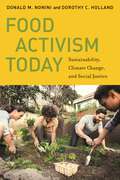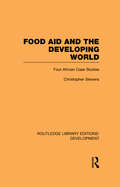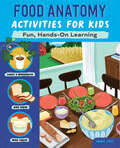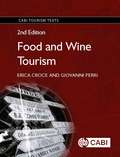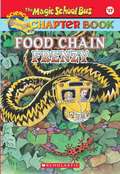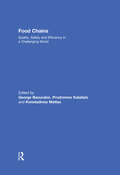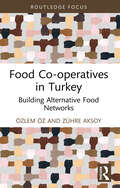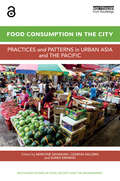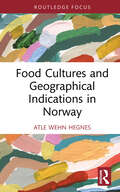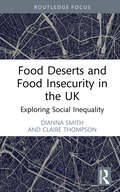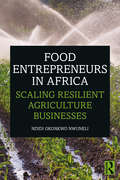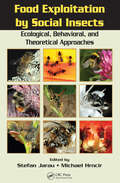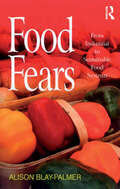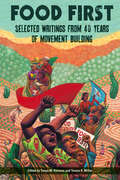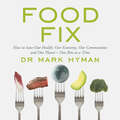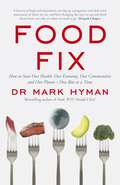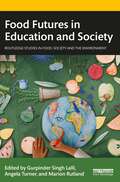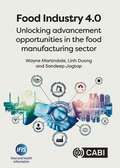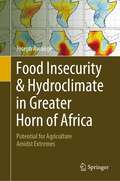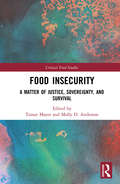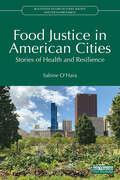- Table View
- List View
Food Activism Today: Sustainability, Climate Change, and Social Justice (Social Transformations in American Anthropology #6)
by Dorothy C. Holland Donald M. NoniniIlluminates how food activism has been taking shape and where it is headedAs climate change, childhood obesity, and food insecurity accelerate at an alarming pace, activists around the country are working to address the pressing need for healthy and sustainable solutions to feed the population. Food Activism Today investigates the new approaches food activists are taking as they formulate alternatives to the current unsustainable agro-industrial food system.Drawing on ethnographic research conducted over an eleven-month period in both urban and rural North Carolina, the volume addresses questions about the moral visions of food activists, how class and racial hierarchies infuse some food activism movements, and how food activism relates to climate change and imminent ecological collapse. Exploring food activism around both local and sustainable food production and food security for lower-income people, the volume finds surprisingly little overlap, with the two movements seemingly remaining distinct approaches (at least for now) to issues around the food system, climate change, and access to healthy food choices.As the US moves into an era in which climate change and neoliberal tensions are conjoined in a looming political crisis, Food Activism Today looks at where food activism is headed, the ethics and issues surrounding alternative approaches to food production, and how food production is related to broader issues of climate change.
Food Aid and the Developing World: Four African Case Studies (Routledge Library Editions: Development Ser.)
by Christopher StevensFood aid is a controversial form of development assistance and this book, first published in 1979, seeks to counter allegations from critics by taking account of both direct and indirect affects. Based on field research in Tunisia, Botswana, Upper Volta and Lesotho, it considers aid from the UK, EEC, USAID, the World Food Programme, Canada and France, and draws a number of policy-orientated conclusions about the impact of food aid on nutrition, consumer prices and agricultural production. In the light of the evidence from field studies it is shown that many of the claims advanced by food aid supporters and by critics cannot be sustained, and that the real impact of food aid is rather different from that assumed by the conventional wisdom on the subject.
Food Anatomy Activities for Kids: Fun, Hands-On Learning (Anatomy Activities for Kids)
by Amber K. StottA hands-on guide to the world of food science for kids ages 8 to 12 The meal on your plate has had many adventures on its way to your belly! Uncover the mysteries of the food you eat with Food Anatomy Activities for Kids, a kids' guide to the incredible history, science, and culture of food. It's packed with easy-to-understand lessons, fun recipes, and engaging experiments to make you feel connected to the food you eat—and make your mouth happy! Travel on a food journey around the world, taste new things, and learn fun facts. Find out all about foods that are foraged or farmed, sweet or savory, baked or preserved—and don't forget foods that you drink! Get involved by predicting the answers to questions, testing your ideas, and drawing conclusions just like a real food scientist. Inside Food Anatomy Activities for Kids, you'll: Follow the life of food—Discover colorfully illustrated lessons on the history and uses of 20 different types of foods. Try awesome activities—Dive into cool experiments like preserving egg yolks with salt, making butter in a mason jar, and growing new fruit from leftover seeds. Think like a scientist—Grab your own notebook and write down your discoveries with the help of in-depth journal prompts after every activity. Take a trip through the wonderful world of food with Food Anatomy Activities for Kids!
Food And Wine Tourism
by Giovanni Perri Erica CroceThis established textbook explores how regions present themselves to tourists experiencing the culture, history, and ambience of a location through the food and wine they produce. It provides practical suggestions and guidelines for establishing a food-related tourism destination and discusses the environment, understanding the food tourist, supply issues, marketing, and best practice strategies. It includes numerous case studies from around the world and plentiful pedagogical features to aid student learning. The second edition: - Contains updated chapters throughout to form a complete and current overview of food and wine tourism - Reviews new emerging destinations and food and wine tourism from a business perspective - Includes new global case studies discussing aspects such an Indian wine, Scottish whisky, and Austrian chocolate tourism. If food and wine tourism is well planned, managed, and controlled, it can become a real economic resource. Suitable for students in tourism and leisure subjects, the practical application provided in this book also makes it an ideal resource for those operating in the food and wine sector.
Food Chain Frenzy (Magic School Bus Chapter Book #17)
by Anne Capeci John SpeirsArnold, Ms. Frizzle, and the whole Magic School Bus crew find themselves in a Food Chain Frenzy as they digest lots of fab facts on ecosystems and eating habits.<P><P> Ms. Frizzle is the weirdest teacher around, and Arnold is her most reluctant student. A field trip on the Magic School Bus can be torture for Arnold, and there is just one thing that can make it worse: his cousin Janet. With his know-it-all relative's visit combined with an all-wheel learning adventure, it is sure to be a school day Arnold won't soon forget. The Friz is always hungry for adventure, and that's just what the class gets. With so much to learn about ecosystems, even Arnold finds himself eating up all the food-chain facts.
Food Chain Frenzy (Magic School House Chapter Book #17)
by Anne Capeci John SpeirsArnold, Ms. Frizzle, and the whole Magic School Bus crew find themselves in a Food Chain Frenzy as they digest lots of fab facts on ecosystems and eating habits.<P><P> Ms. Frizzle is the weirdest teacher around, and Arnold is her most reluctant student. A field trip on the Magic School Bus can be torture for Arnold, and there is just one thing that can make it worse: his cousin Janet. With his know-it-all relative's visit combined with an all-wheel learning adventure, it is sure to be a school day Arnold won't soon forget. The Friz is always hungry for adventure, and that's just what the class gets. With so much to learn about ecosystems, even Arnold finds himself eating up all the food-chain facts.
Food Chains and Webs
by Delta EducationAn introduction to food webs and ecosystems for third and fourth grade.
Food Chains and Webs
by Holly WallaceFood Chains and Webs looks at the way plants and animals in a particular place are connected by what they eat. Because green plants can make their own food, they begin every food chain and web. All animals, including people, rely on plants for their food.
Food Chains: Cooperative Approaches For A Changing World (Cooperative Management Ser.)
by Konstadinos Mattas George Baourakis Prodromos KalaitzisFood Chains: Quality, Safety and Efficiency in a Challenging World addresses the many issues facing European food producers and other food chain stakeholders, who endeavour to improve their competitive position in a highly competitive world food market. The Food Chain is one of the main economic pillars in Europe, providing employment and opportunities for economic development in rural areas. It is therefore imperative to continuously monitor the changes that affect the sector, in order to allow stakeholders to respond promptly and effectively to the new market conditions. Adjusting to the new market involves new technology, globalization, demographic and social changes within a challenging market environment. In order to adopt these new market parameters, food chain stakeholders need to adapt their activities in order to gain in terms of effectiveness and efficiency.This book was originally published as a special issue of Food Economics - Acta Agriculture Scandinavica, Section C.
Food Co-operatives in Turkey: Building Alternative Food Networks (Routledge Focus on Environment and Sustainability)
by Özlem Öz Zühre AksoyThis book addresses the roles played by food co-operatives in the attempt to build alternative food networks, drawing on an in-depth analysis of case studies in Turkey. While many existing studies focus on food co-operatives and alternative food networks in the Global North, this book provides an important insight into a country from the Global South and, in doing so, not only provides a novel perspective but also challenges the rigid North–South categorization. The book provides a rounded view by examining both a producer and a consumer co-operative: BÜKOOP is a university-based consumer food co-operative, and the Vakıflı co-operative is a food-producing co-operative located in the Hatay province on the Mediterranean coast of Turkey. These two co-operatives, which have been working together for more than ten years, share the dream of establishing a network of co-operatives, in which producers exist in solidarity with consumers, blurring the dichotomy of producer versus consumer as well as rural versus urban. In addition to contributing towards a better understanding of the urban–rural divide, within the framework of alternative food networks, the in-depth analysis of these two cases enables us to explore how food co-operatives develop and how they keep their commitment to their original goals and ideals so as to help build an alternative food system. The lessons we learn from these two working case examples highlight the successes and areas of improvement for food co-operatives. They also provide evidence against the pessimism about alternative food networks by demonstrating that co-operatives can democratize both production and consumption. This book will be of interest to students and scholars studying alternative food networks, food justice, food sovereignty, transformation towards sustainable food systems, social movements, and the urban–rural divide.
Food Consumption in the City: Practices and patterns in urban Asia and the Pacific (Routledge Studies in Food, Society and the Environment)
by Suren Erkman Marlyne Sahakian Czarina SalomaFood consumption patterns and practices are rapidly changing in Asia and the Pacific, and nowhere are these changes more striking than in urban areas. This book brings together scholars from anthropology, sociology, environmental studies, tourism, architecture and development studies to provide a comprehensive examination of food consumption trends in the cities of Asia and the Pacific, including household food consumption, eating out and food waste.The chapters cover different scales of analysis, from household research to national data, and combine different methodologies and approaches, from quantifiable data that show how much people consume to qualitative findings that reveal how and why consumption takes place in urban settings. Detailed case studies are included from China, India, Japan, Malaysia, Philippines, South Korea and Vietnam, as well as Hawai'i and Australia. The book makes a timely contribution to current debates on the challenges and opportunities for socially just and environmentally sound food consumption in urbanizing Asia and the Pacific.Chapter 3 of this book is freely available as a downloadable Open Access PDF at http://www.taylorfrancis.com under a Creative Commons Attribution-Non Commercial-No Derivatives (CC-BY-NC-ND) 3.0 license.
Food Cultures and Geographical Indications in Norway (Routledge Focus on Environment and Sustainability)
by Atle Wehn HegnesThis book analyses the implementation and challenges of using Geographical Indications in Norway. Adapting the modern and global system of Geographical Indications (GIs) to food cultures is a recurring challenge. This text uses Norway as a case study to describe, understand, and explain the socio-cultural adaptation of GIs. The empirical analysis shows that administrators, producers, consultants, and others make a significant effort to adapt the scheme to Norwegian food culture and the food culture to the scheme. Through the development and use of a new conceptual framework, the book continues to show how adaptations occurred and their influence on the development of the Norwegian food culture. The author also reflects upon the status of Norwegian GIs in emerging food cultural contexts related to sustainable and technology change. In summary, this book exhibits the connection between modern global legislative arrangements and traditional local products, providing a springboard for further research on cultural adaptation work of GIs in established and future global food cultures. This book will be of interest to researchers, policymakers, and students in agri-food studies, sociology of food and agriculture, agricultural and rural development, and cultural studies.
Food Deserts and Food Insecurity in the UK: Exploring Social Inequality (Routledge Focus on Environment and Sustainability)
by Claire Thompson Dianna SmithThis book examines the social inequalities relating to food insecurity in the UK, as well as drawing parallels with the US. Access to food in the UK, and especially access to healthy food, is a constant source of worry for many in this wealthy country. Crises, such as the COVID-19 pandemic, have coincided with a steep rise in the cost of living, meaning household food insecurity has become a reality for many more households. This book introduces a new framework to examine the many influences on local-level food inequalities, whether they result from individual circumstances or where a person lives. The framework will allow researchers new to the field to consider the many influences on food security, and to support emerging research around different sub-topics of food access and food security. Providing a thorough background to two key concepts, food deserts and food insecurity, the book documents the transition from area-based framing of food resources, to approaches which focus on household food poverty and the rise of food banks. The book invites researchers to acknowledge and explore the ever changing range of place-based factors that shape experiences of food insecurity: from transport and employment to rural isolation and local politics. By proposing a new framework for food insecurity research and by drawing on real-world examples, this book will support academic and applied researchers as they work to understand and mitigate the impacts of food insecurity in local communities. This book will be of great interest to students and scholars of food and nutrition security, public health, and sociology. It will also appeal to food policy professionals and policymakers who are working to address social inequalities and improve access to healthy and nutritious food for all.
Food Education and Gastronomic Tradition in Japan and France: Ethical and Sociological Theories (Routledge Food Studies)
by Haruka UedaDrawing on ethical and sociological theories of food, this book presents a new approach to food education that moves beyond nutrition-centred education. Food education has gained increasing scientific and political importance in many countries as a promising way to change contemporary eating. However, many practices fail to address two epistemological obstacles regarding its very components – ‘food’ and ‘education’. Food has largely been thought of from a nutritionistic viewpoint alone and the ethical issues over children’s freedom of choice and well-being have been absent. This book resolves these problems by applying ethical and sociological theories of food and analysing food education in two pioneering countries: Japan and France. The book focuses on taste education and gastronomy as two key concepts which have great potential to positively impact food education. Taste education is a promising alternative to nutrition-centred pedagogy which foregrounds the experience and pleasure of eating food, creating an environment for taste sensibility and food curiosity. From taste education, the picture can be broadened to examine the role and impact of gastronomy in food education. Examining the cultural traditions of France and Japan reveals how gastronomy can impact eating habits and food cultures and how these criteria should be an intrinsic part of food education. The book concludes by constructing an integrative theory for food education that moves beyond nutrition-centred education for the benefit of one’s well-being. This book will greatly interest students, scholars, policymakers and educators working on food education, food-related issues at the intersection between nutritional and social sciences, and ‘gastronomes’ searching for a pedagogical guide for developing their capabilities to eat in a more humanistic way.
Food Entrepreneurs in Africa: Scaling Resilient Agriculture Businesses
by Ndidi Okonkwo NwuneliEntrepreneurs are the lifeblood of the agriculture and food sector in Africa, which is projected to exceed a trillion dollars by 2030. This book is the first practical primer to equip and support entrepreneurs in Africa through the process of starting and growing successful and resilient agriculture and food businesses that will transform the continent. Through the use of case studies and practical guidance, the book reveals how entrepreneurs can leverage technology and innovation to leapfrog and adapt to climate change, ensuring that Africa can feed itself and even the world. The book will: Inspire aspiring entrepreneurs to start and grow resilient and successful businesses in the agriculture and food landscapes. Equip aspiring and emerging entrepreneurs with practical knowledge, skills, and tools to navigate the complex agriculture and food ecosystems and develop and grow high-impact and profitable businesses. Enable aspiring and emerging entrepreneurs to develop scalable business models, attract and retain talent, leverage innovation and technology, raise financing, build strong brands, shape their ecosystem, and infuse resilience into every aspect of their operations. The book is for aspiring and emerging agribusiness entrepreneurs across Africa and agribusiness students globally. It will also inspire policymakers, researchers, development partners, and investors to create an enabling and supportive environment for African entrepreneurs to thrive.
Food Exploitation By Social Insects: Ecological, Behavioral, and Theoretical Approaches
by Stefan Jarau Michael HrncirOmnipresent in virtually all terrestrial ecosystems and of undisputed ecological and economical importance, the study of social insects is an area that continues to attract a vast number of researchers. As a consequence, a huge amount of information about their biology and ecology has accumulated. Distilling this scattered information into a highly
Food Fears: From Industrial to Sustainable Food Systems
by Alison Blay-PalmerThe industrial food system of the West is increasingly perceived as problematic. The physical, social and intellectual distance between consumers and their food stems from a food system that privileges quantity and efficiency over quality, with an underlying assumption that food is a commodity, rather than a source of nourishment and pleasure. In the wake of various food and health scares, there is a growing demand from consumers to change the food they eat, which in turn acts as a catalyst for the industry to adapt and for alternative systems to evolve. Drawing on a wealth of empirical research into mainstream and alternative North American food systems, this book discusses how sustainable, grass roots, local food systems offer a template for meaningful individual activism as a way to bring about change from the bottom up, while at the same time creating pressure for policy changes at all levels of government. This movement signals a shift away from market economy principles and reflects a desire to embody social and ecological values as the foundation for future growth.
Food First: Selected Writings from 40 Years of Movement Building
by Tanya M Kerssen Teresa K MillerThis book looks back on forty years of writings from the Oakland-based Institute for Food and Development Policy, better known as Food First, on the occasion of its 40th anniversary. The book highlights the breadth and depth of the organization's published works, addressing issues such as hunger, international trade, US foreign policy, the Green Revolution, agroecology, climate justice, land reform, food and farm workers' rights, and food sovereignty.
Food Fix: How to Save Our Health, Our Economy, Our Communities and Our Planet – One Bite at a Time
by Mark HymanOur most powerful tool to reverse the global epidemic of chronic disease, heal the environment, reform politics, and revive economies is food. What we eat has tremendous implications not just for our waistlines, but also for the planet, society, and the global economy. What we do to our bodies, we do to the planet; and what we do to the planet, we do to our bodies.In Food Fix Mark Hyman explains how our food and agriculture policies are corrupted by money and lobbies that drive our biggest global crises: the spread of obesity and food-related chronic disease, climate change, poverty, violence, educational achievement gaps, and more. He provides solutions for citizens, businesses, and policy makers to create a healthier world, society, and planet.Pairing the latest developments in nutritional and environmental science with an unflinching look at the dark realities of the global food system and the policies that make it possible, Food Fix is a passionate call to arms that will change the way you think about - and eat - food forever.(P) 2020 Hachette Audio
Food Fix: How to Save Our Health, Our Economy, Our Communities and Our Planet – One Bite at a Time
by Mark HymanOur most powerful tool to reverse the global epidemic of chronic disease, heal the environment, reform politics, and revive economies is food. What we eat has tremendous implications not just for our waistlines, but also for the planet, society, and the global economy. What we do to our bodies, we do to the planet; and what we do to the planet, we do to our bodies.In Food Fix, New York Times best-selling author Mark Hyman explains how food and agriculture policies are corrupted by money and are driving a global crises: the spread of obesity and food-related chronic disease, climate change, poverty, violence, educational achievement gaps, and more. He provides solutions for citizens, businesses, and policy makers to create a healthier world, society, and planet.Pairing the latest developments in nutritional and environmental science with an unflinching look at the dark realities of the global food system and the policies that make it possible, Food Fix is a passionate call to arms that will change the way you think about - and eat - food forever.'If you're overwhelmed by the scale of the world's problems, and wondering what you can do in your own life to start, Food Fix is for you. Dr. Hyman deftly connects the dots between education, health, climate science, and the food we eat every day, showing that the choices we make about the food we put on our plates has consequences that ripple around the world.' - Arianna Huffington
Food Futures in Education and Society (Routledge Studies in Food, Society and the Environment)
by Angela Turner Gurpinder Singh Lalli Marion RutlandThis book brings together a unique collection of chapters to facilitate a broad discussion on food education that will stimulate readers to think about key policies, recent research, curriculum positions and how to engage with key stakeholders about the future of food. Food education has gained much attention because the challenges that influence food availability and eating in schools also extend beyond the school gate. Accordingly, this book establishes evidence-based arguments that recognise the many facets of food education, and reveal how learning through a future's lens and joined-up thinking is critical for shaping intergenerational fairness concerning food futures in education and society. This book is distinctive through its multidisciplinary collection of chapters on food education with a particular focus on the Global North, with case studies from England, Australia, the Republic of Ireland, the United States of America, Canada and Germany. With a focus on three key themes and a rigorous food futures framework, the book is structured into three sections: (i) food education, pedagogy and curriculum, (ii) knowledge and skill diversity associated with food and health learning and (iii) food education inclusivity, culture and agency. Overall, this volume extends and challenges current research and theory in the area of food education and food pedagogy and offers insight and tangible benefits for the future development of food education policies and curricula. This book will be of great interest to students, scholars, policymakers and education leaders working on food education and pedagogy, food policy, health and diet and the sociology of food.
Food Industry 4.0: Unlocking Advancement Opportunities in the Food Manufacturing Sector
by Dr Wayne Martindale Dr Linh Duong Dr Sandeep JagtapThis book provides industry insights and fresh ideas for the advancement of the most vital global industry - food. Drawing on their industry and academic expertise the authors have identified three controlling aspects of food business operations that can unleash long term success: consumer health and wellbeing; product and process sustainability; and harnessing advances in digitalization.. If developed to their maximum potential these factors have the capability to revolutionize the food sector. Food Industry 4.0 highlights advancement opportunities for the food manufacturing sector, including innovation in products, processes and services, as it seeks to combine productive, efficient and sustainable practices. The contents address: Mapping data, new approaches for food system applications. The perfect meal and making a balanced global diet possible. Industry 4.0 applications in the food sector: robotics and automation, big data, Internet of Things, cybersecurity. Resource utilization in the food manufacturing sector. Resilience and sustainability in food supply chains. Environmental and social governance in our food system. It is of significant benefit to food industry practitioners working in operational and product development roles, academic researchers, policy makers, students, and food sector professionals.
Food Insecurity & Hydroclimate in Greater Horn of Africa: Potential for Agriculture Amidst Extremes
by Joseph AwangeThis book will benefit users in food security, agriculture, water management, and environmental sectors. It provides the first comprehensive analysis of Greater Horn of Africa (GHA)’s food insecurity and hydroclimate using the state-of-the-art Gravity Recovery and Climate Experiment (GRACE) and its Follow-on (GRACE-FO)’s, centennial precipitation, hydrological models’ and reanalysis’ products. It is here opined that GHA is endowed with freshwater (surface and groundwater) being home to the world's second largest freshwater body (Lake Victoria) and the greatest continental water towers (Ethiopian Highlands) that if properly tapped in a sustainable way, will support its irrigated agriculture as well as pastoralism. First, however, the obsolete Nile treaties that hamper the use of Lake Victoria (White Nile) and Ethiopian Highland (Blue Nile) have to be unlocked. Moreover, GHA is bedevilled by poor governance and the ``donor-assistance” syndrome; and in 2020-2021 faced the so-called ``triple threats’’ of desert locust infestation, climate variability/change impacts and COVID-19 pandemic. Besides, climate extremes influence its meagre waters leading to perennial food insecurity. Coupled with frequent regional and local conflicts, high population growth rate, low crop yield, invasion of migratory pests, contagious human and livestock diseases (such as HIV/AIDs, COVID-19 & Rift Valley fever) and poverty, life for more than 310 million of its inhabitants simply becomes unbearable. Alarming also is the fact that drought-like humanitarian crises are increasing in GHA despite recent progress in its monitoring and prediction efforts. Notwithstanding these efforts, there remain challenges stemming from uncertainty in its prediction, and the inflexibility and limited buffering capacity of the recurrent impacted systems. To achieve greater food security, therefore, in addition to boosting GHA's agricultural output, UN Office for the Coordination of Humanitarian Affairs suggest that its “inhabitants must create more diverse and stable means of livelihood to insulate themselves and their households from external shocks”. This is a task that they acknowledge will not be easy as the path ahead is “strewn with obstacles namely; natural hazards and armed conflicts”. Understanding GHA’s food insecurity and its hydroclimate as presented in this book is a good starting point towards managing the impacts of the natural hazards on the one hand while understanding the impacts associated with extreme climate on GHA's available water and assessing the potential of its surface and groundwater to support its irrigated agriculture and pastoralism would be the first step towards “coping with drought” on the other hand.The book represents a significant effort by Prof Awange in trying to offer a comprehensive overview of the hydroclimate in the Greater Horn of Africa (GHA). Prof Eric F. Wood, NAE (USA); FRSC (Canada); Foreign member, ATSE (Australia).
Food Insecurity: A Matter of Justice, Sovereignty, and Survival (Critical Food Studies)
by Tamar MayerThis book explores the experiences, causes, and consequences of food insecurity in different geographical regions and historical eras. It highlights collective and political actions aimed at food sovereignty as solutions to mitigate suffering. Despite global efforts to end hunger, it persists and has even increased in some regions. This book provides interdisciplinary and historical perspectives on the manifestations of food insecurity, with case studies illustrating how people coped with violations of their rights during the war-time deprivation in France; the neoliberal incursions on food supply in Turkey, Greece, and Nicaragua; as well as the consequences of radioactive contamination of farmland in Japan. This edited collection adopts an analytical approach to understanding food insecurity by examining how the historical and political situations in different countries have resulted in an unfolding dialectic of food insecurity and resistance, with the most marginalized people—immigrants, those in refugee camps, poor peasants, and so forth—consistently suffering the worst effects, yet still maintaining agency to fight back. The book tackles food insecurity on a local as well as a global scale and will thus be useful for a broad range of audiences, including students, scholars, and the general public interested in studying food crises, globalization, and current global issues.
Food Justice in American Cities: Stories of Health and Resilience (Routledge Studies in Food, Society and the Environment)
by Sabine O’HaraThis book documents food insecurity in urban communities across the United States and asks whether emerging urban food and agriculture initiatives can address the food security needs of American city dwellers. While America has sufficient food to feed its entire population, 38 million people are food insecure, with urban communities and communities of color having long borne the brunt of food inequalities. This book traces the evolving story of food by describing the people behind food system statistics, focusing on cities and suburban communities across America. In doing so, it raises questions not only about food security but about a food economy that can foster justice and sustainability and combat hunger and waste. By linking human faces to the data, the book reveals the many connections between food insecurity and unsustainable practices. The book concludes by discussing some of the pathways toward a more sustainable and just food system by linking the food system to the larger economy and the many sectors that are connected to food. Because of these multifaceted connections, food can be a unique catalyst for creating pathways toward a more just and sustainable economy that is more aligned with nature. This book will be of great interest to students and scholars of food justice, food security, urban food and agriculture, urban sustainability, and sustainable food systems more broadly.
